What connotations come to mind with the words “car keys?” Bad thoughts, like frantically ransacking your house, bags and pockets in search of them? Good thoughts, like being handed them for the first time at a dealership or flicking your wrist and hearing the engine come alive?
Either way, these experiences are likely to soon be stowed-away memories of a different time: The truth is, the history of car keys as we know them is quickly coming to a close.
Just about every other aspect of automotive technology has drastically evolved over the past century, and the keys we use to open and start our cars are no different. But car key history is unique in that instead of simply improving the feature, current technology has rendered traditional car keys obsolete, sending them the way of the dodo, car ashtrays and crank windows.
That renders the age-old question: How did we get here? Let’s take a look back.
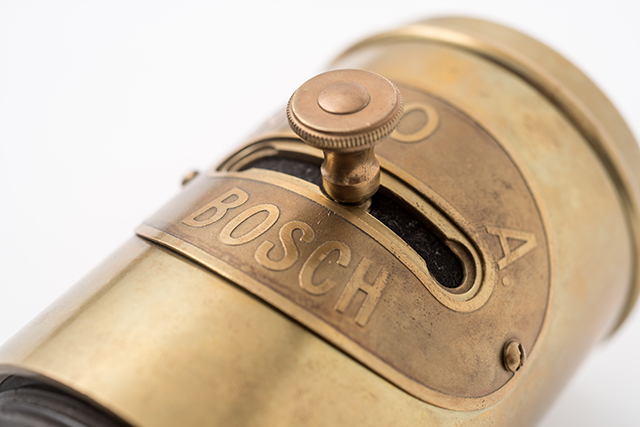
The History of Car Keys Begins
Car key history can be traced back to 1910, but these early versions didn’t start the engine or ignition. Instead, the first car keys controlled the ignition’s electrical circuit. Using the key, car owners could switch off the flow of electrical current, making it impossible to start the vehicle. Once the switch was on, the ignition could be activated, although drivers still had to then crank up the engine.
Soon after, keys that could lock and unlock both the electrical circuit and the ignition became more common.
Because it was still impossible to start the engine without a key, car theft was not a concern, and “locking” a car wasn’t a practice. In fact, most early automobiles were roofless and some were even door-less.
Mid-Century Car Keys
A major milestone in car key history occurred in 1949 when Chrysler unveiled the first car key that could start a vehicle’s engine all on its own. It was able to do so through the use of an ignition tumbler, or ignition lock cylinder.
In 1965, Ford became the first manufacturer to introduce double-sided keys that could be inserted into the tumbler either way. While seemingly elementary by today’s standards, these types of car keys remained the norm for decades.
This was also around the same the time the dual key, which could both start the car and unlock the doors, took hold. Prior to the 1960s, some vehicles still required two separate car keys.
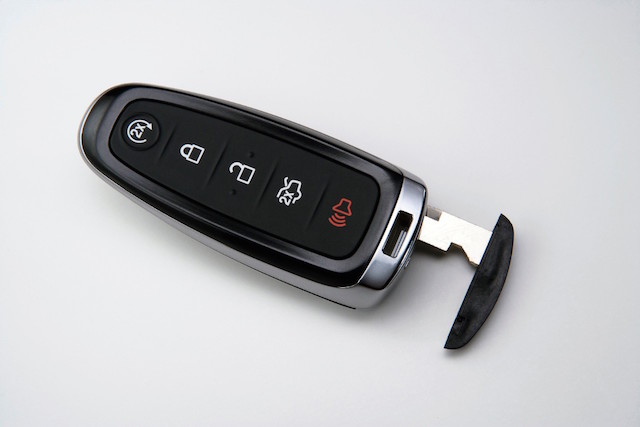
Car Keys Meet Technology
Car key evolution was mostly dormant for the next quarter century but took some momentous leaps in the 1990s. It was this decade that saw the rise of the now ubiquitous key fob.
Remote keyless entry fobs allowed car owners to lock and unlock vehicle doors from afar by emitting a coded signal through radio waves to a receiver in the car. As technology developed, key fobs gained more functions, such as opening the trunk or sliding doors and starting the engine remotely.
(If you’re curious about the strange name, according to The Atlantic, “fob” may come from the word “fuppe,” which means “pocket” in the low German dialect.)
Car fobs are very expensive to replace. Make sure you’re protected with AAA’s Tire & Wheel Program, which covers lost keys and key fobs up to $5,000.

Car Keys Today
The traditional, mechanical car key is quickly becoming a thing of the past – if it’s not already a relic of automotive history. Almost all of today’s new vehicles have some version of a keyless entry and push-button start system. In fact, according to consumer auto research firm Edmunds, 91% of 2019 model-year vehicles had keyless ignitions. That’s up from 72% in 2014.
We’ve come a long way from having to carry one key for the engine and one key for the doors. But apparently one key is still one too many: Drivers can now store a digital car key on – where else – their phones.
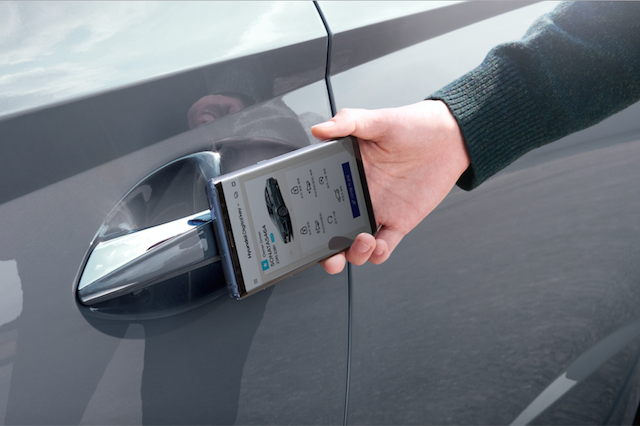
Apple’s Wallet app includes a feature to add your car key. In order to do this, you need to have a compatible car as well as an iPhone or Apple Watch. Once installed, a user simply places their phone or watch next to the car’s door handle to unlock the vehicle. To start the car, they just place the phone or watch in the car’s key reader and press the start button. When an owner wants to share their key, they can simply send an iMessage to that user, which tells them how to add and use the car key.
Tesla owners can use the company’s smartphone app to do many of the same things. The app can track a driver’s smartphone from up to 30 feet away and automatically unlock the doors by the time they reach the car. But the electric automaker isn’t alone. About 31 brand marques, including BMW, Chevrolet, Chrysler, Dodge, Hyundai and Lincoln offer digital car keys, making the trend’s rise seem more assured and imminent.
What are your thoughts on car keys today? Do you like the idea of a digital key on your phone or would rather have a tangible key you can hold? Let us know in the comments below?
For more automotive history, visit AAA.com.
110 Thoughts on “The History of Car Keys”
Leave A Comment
Comments are subject to moderation and may or may not be published at the editor’s discretion. Only comments that are relevant to the article and add value to the Your AAA community will be considered. Comments may be edited for clarity and length.



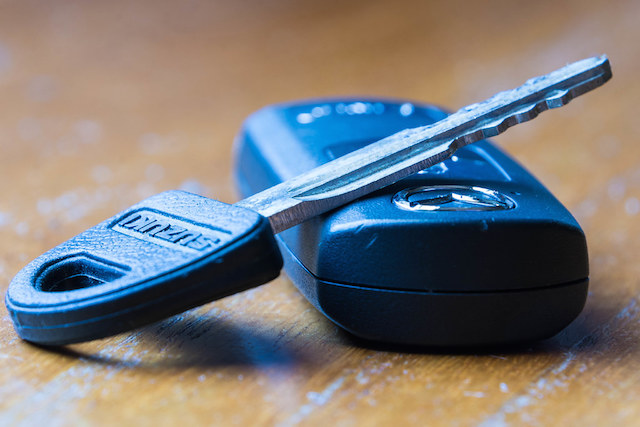



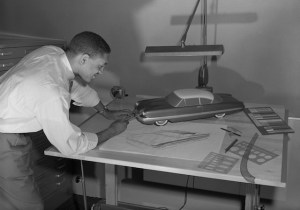









I stumbled across this old article, and as to the praise of automation – what a load of crap. Companies today are making products and introducing trends that they want people to follow, and people blindly accept them like the sheep they are. The more electronics you put in a vehicle, the more recalls. Just ask Ford. A key gives you piece of mind..when you lock the door manually you know its locked and you don’t have to worry about hackers opening it. Cars are now rolling robots that can be hacked or hijacked by either hackers or the federal government. It wont be long before every thing we own is automated and we will have no control over anything. Ironically, the one thing we should do online is being ignored intentionally – VOTING. A properly managed online voting system would eliminate a lot of cheating, but that wont happen. The purpose of automation is to take control away from citizens, not let them keep it. Example – self driving cars. If people are too lazy to turn a key or drive their own cars, get the hell off the road!
A thin key is best, IMO.
But keys aren’t simple anymore. You need to make sure that the copy of your key STARTS your car and does more than OPEN your vehicle.
To save money, car manufacturers have slowly removed locks around the vehicle: first the trunk, then the passenger door and now the driver door. If your driver door has ever been blocked by someone with poor driving skills (or are just plain inconsiderate), access via another method is necessary. Sure a key fob helps but as others have said those are large, somewhat clunky, subject to damage (especially water), and expensive to replace.
Though I prefer keys but we have one vehicle with an additional keypad entry and I’ll admit it’s nice to NOT carry a key when out hiking if I get back to the car before my husband. But that’s one of four vehicles we own. I can’t imagine memorizing codes for each vehicle. Setting all of them to the same number? That’s fine except when a factory reset happens and your code reverts to the manufacturer’s setting.
Spare keys (without fobs) tend to be slim, lightweight and can fit into a wallet slot or other tiny space. When I run or might be taking a swim, key fobs are a problem. Tying a key & fob to my shoe are an option and painful if I take a long run due to the constant pounding against my foot. Swimming? The only option is a metal key or a vehicle with keyless entry.
The thought of using my phone? Dead battery or phone? How do I access? The dead battery is a reality and I don’t want to take my phone along on my run or swim.
I hope the auto industry listens. Everyone I know prefers a KEY. Also please keep costs down with this simple device.
Things haven’t really changed all that much; you still have to find your “key fob” if you want to go anywhere and the fob for my car has a removable key incase the battery in the fob is dead or it just isn’t working. So you still need an object in your pocket to operate your car and for men, some of the key fobs are pretty large to carry around in your pants pocket.
I own a classic 1966 Chevy Impala, it has two keys, one for the ignition and one for the doors and trunk and they are tiny compared to later car keys, now they would be easy to lose!
I prefer a key.
When I go swimming at the beach or pool, I take the metal key out of the fob and lock the fob in the car. Then I can tie the key to the string in my swimsuit waist band so I don’t lose it in the pool or beach. I can’t swim with the fob and don’t want to leave it on the beach with my shirt and shorts where it could be stolen. If the fob didn’t have a metal key inside, I don’t know what I would do!
when the car battery is low you can;t open the car doors with the fob you have to use the key on the fob to open the door I found that out there is a whole in the door handle you stick the key in the whole and pull off the small part of the latch and stick in the key & turn it
Digital starters also create issues with car theft. Thieves have a way of cracking the code and of not just the garage door opener, but the car’s key code. Police recommend keeping key fobs in a special box that the digital readers can’t penetrate.
I agree in general with the complaints about technology and hate the idea of moving the “key” to cell phones, but I’m surprised that no one has said that every keyless start car has a backup method to start the car even if the key fob battery has died. And only the new Mustang Mach E does not offer a backup to get inside other than the phone app. Otherwise, as many noted, nearly every key fob has a mechanical key in it that will unlock the driver’s door. Tesla uses a placement method to open. The key fob needs to be held near a detector on the body of the car (and it works!).
These comments. Wow. I’m an early adopter of technology and drive an electric car with no key. My house has an electric lock on the front door. Freedom baby! No keys at all!
First comment I can say “agreed”.
I don’t want anything that has to do with a smartphone. Keys please!
As with most new “tek no logicgy”, whenever you see the phrase “new and improved” somehow expect to be getting screwed.
Next time someone changes your light bulb make sure they are wearing gloves. Any light oil film from your fingers will reflect the light within, raising the temperature and drastically reduce the life of the bulb
Keys, please!
I drive a 1999 Saturn with hand crank windows & a manual key to start the car. Don’t like the idea of technology taking over what should be a personal function to start & drive a car. I keep a spare key with me in case I need it.
I want to continue to use a key, It is easier and more foolproof than a fob and all the other tech wonders which I have no use for, people are just getting lazier and more
dependent on having things done for them and when they go wrong you suffer. When something does go wrong it will be very expensive to fix and a waste of your time bringing it to the dealership or garage.
As one can see, most of we seniors have a lot of problems with the technology forced upon us. Some of it may be good,but a lot of drawbacks. One suggestion-a beeper in the fob/key.so that if you can’t find it,you can call a number and set off the beep. One more, I once lost my key/fob somewhere in my house,and called my friend to say I would be late. He said,”look in the garbage”.I thought he was nuts,but I looked-there it was!
My Mazda has the “proximity key” and pushbutton start, but it the car battery is dead, the system does not work, so I have the backup key inside the FOB. However, when I unlock the door, I still cannot get into the trunk to get my battery jumper! I want my old keys back!
Good grief. Stop the useless and unnecessary techno crap with cars. Give me a key or I won’t buy a “modern” car.
Whether one likes the fob or the keys, if you left a pre-fob car for three or four months it would start right up (Unless you had a remote starter installed,) but almost all fob cars will have a dead battery if not run every three or four weeks. Why you ask? The fob cars require a radio receiver that operates all the time to hear the commands and do what it is programmed to do. If you want a car that does nor run it’s own battery down every three weeks or so, you are OUT OF LUCK for anything that has four wheels.
In my opinion, having a key is much safer. I do not want to have to rely on a phone that can easily be lost, stolen or inoperable.
WELL.. TECHNOLOGY DOES NOT REPLACE EVERYTHING. I PREFER TO HAVE THE KEY FOB. THIS BUSINESS OF USING MY I PHONE IS RISKY… BATTERY FAILURE OR ANY PHONE MALFUNCTION WILL CREATE HEADACHES. SOON WE WILL HEAR THAT SOMEONE WAS ABLE TO ACCESS YOUR CAR BECAUSE THE PHONE WAS HACKED OR SOMETHING LIKE THAT.
Push Start buttons are not infallible either. Mine broke after only 4 years of use! At first did not know it was that , as it was not completely broken, thought it could be fob problem and bought new batteries, etc… At the same time, the digital maintenance screen was throwing out many ‘other’ errors because of this issue but the car was not smart enough to tell me it was a problem with the push start button.
I prefer a key. Dead batteries can be a big deal to rectify. The fob is actually a pain to carry around. Replacing the button battery in my Hyundai is like disarming a bomb!
A key will not go dead and takes up very little room. I don’t want a fob-a-ma-jig, I want a good, solid, dependable car key.
GIVE ME A KEY!! My friend decided to let his son use his car one day but to do so he needed a ride to work. About an hour after being dropped off at work his son called saying that he was locked out of the car. The REASON? my friend had the fob in his pocket. Similar situation when the parking attendant forgot to hand the fob back to the driver!! The fob is the only reason why I still have my 17 year old car. The cars are now bundled with the fob so all the trim levels that I need come with fobs. Shall I start on spare tires? Someone please forward these comments to the auto makers. Obviously we are not in their surveys.
Like the Key. Hate the Fob. Smart phone is stupid.
My remote battery went dead. My wife had the spare in her pocketbook 1 hour away. The spare in the garage was dead. The car manufacture stated I should not leave the spare in a unheated garage, that is why it was dead. I am 79 years old and have been driving a long time. This is nuts.
I believe most fobs do have a physical key that you can remove to open the door. Hence, having a spare battery inside the car will work out well.
A bunch of folks have said it better than I could: I want a car key! Whose idea was the fob anyway?
If I lost or broke my phone, or even if it lost its charge I’d be up doubly, triply up a creek if I didn’t have a car key. At least with a key, I could drive to the phone store and get it fixed or replaced. I can imagine a number of messes if everything were on my phone. If my phone loses its charge nowadays and I’m away from home, I can at least unlock my car and charge up my phone. I say keep them separate.
I definitely prefer a key…. I have so often dropped the fob under the seats, can’t find it in which bag or pocket. You always know where your keys are! How many times have I inadvertently opened my trunk ????
Looks to me the majority prefers a key. Lets keep the pressure on to bring back the key to operate our cars. Too many problems can’t the Fob
I definitely prefer a key…. I have so often dropped the fob under the seats, can’t find it in which bag or pocket. You always know where your keys are! How many times have I inadvertently opened my trunk ????
I would like the key to always be available.
A car key is primitive and free of the complexities of breakdowns and works 100% of the time. A car key also requires and promotes careful habits of the owner and, therefore, contributes to an orderly and careful life style. Car keys 10; electronics 5.
Absolutely prefer a KEY. Fob is way too expensive an item to replace. I like the manual opening of the car door as a back up too. My 2007 Subaru is the last year before electronics were introduced and at 214,000 miles it has served me well. Door lock and unlock is on a separate piece from the key, and there is a key insert in the door handle. The small battery lasts for years. The last thing I want is my car interfaced with my phone.
I used to be able to get a copy of my key for $2.00. Now it’s $100.00. That’s the ONLY reason for the change. And there’s no need for it to cost that much, it’s just a flash drive, and a tiny one. A key fob has ZERO advantage over a key.
Computers are great. They are not ALWAYS the best way to do things, and this is an example.
TODAYS CARS ARE JUST TELEPHONES ON WHEELS. THEY FORCE THEIR “CONTROL” ON US WE DO NO HAVE ANY CHOICE. OF COURSE CAR KEYS ARE BETTER AND SAFER!
I should think that if a phone can become a car key by simply sending it a code, then anyone with such a phone can steal your car. I don’t like the idea.
I also like car keys. There is a reason the expression “keep it simple stupid” never goes out of style. The more complex the more problems. I hope we haven’t gotten so lazy we cannot start our own cars
Key fobs of today are the answer to a question nobody asked. Give me a real key any day. That way I can never lock myself our of my car.
I prefer to have both options.
After driving my new car for about 6 months I came out of a store to return home. I couldn’t open the doors or start the car because the battery in the FOB was dead. I could use the “hidden” key in the FOB to open the doors but still could go nowhere. I had to call home and have my spouse bring my the spare FOB.
I prefer keys.
My key fob is always bumping something else in my pocket and doing random functions. I can be working in the garden and accidentally remotely start the car in the garage, filling it with carbon monoxide. I feel safer if I approach my car and find it locked. If it automatically unlocks from 30 feet away, and I find it unlocked, I wonder if I have been forgetting to lock it. It’s nice to find my car by remotely making it beep, as long as this also locks it. Remote locking is convenient in case you don’t remember to lock it until after you’ve walked away. But remote start and remote unlock are dangerous. A key in the fob is a lifesaver when there’s a battery problem.
I prefer the key. Far more reliable. No dependence on battery to enter the vehicle or engage it to start.
I say “keep it simple” and stick to the reliable metal key. Don’t rely on a battery operated device to lock and unlock the vehicle. Batteries do eventually fail and who wants that in an emergency. As the old saying goes, “If it’s not broken, don’t fix it”.
I really enjoyed this and shared it with friends who I thought might. Thank you.
Having an old style key in the FOB is great for back-up. You never know when the battery will fail. Some things shouldn’t go out of style…
I prefer keys. The battery dying on a fob is a real issue, and fumbling with a phone seems ridiculous. Those fobs are very expensive to replace. I have a 97 Honda Civic that runs well. It has a key, and I’m likely to keep it for the same reason others have mentioned: not to have to deal with that expensive fob.
I prefer a key, too. I am young enough to remember that using the family car meant getting permission from my mom or dad—that permission in the form of them handing me their keys to the car. What would we do today? What do the legal-eagles think? The keys were a tangible evidence of permission granted.
I would definitely prefer a key. The fob is heavy. When I pick up my car at night or in a remote area, I always have a second of worry if the battery might have died. I’d be stuck. Also, being a senior, I remember the days when you tapped a button on the floor with your left foot to control the high/dimmer lights. The left foot does nothing, whereas if you have to free one hand to jiggle the control while you’re trying to turn, it’s also a moment of anxiety. Otherwise, glad for a.c., seat controls, better speakers.
I am old enough to remember when some cars offered a switch buy no lock.
Keys preferred – less bulk and an extra one or two can be used if lost – fob is heavy and with phone etc – too much weighing us down. I want to be in control – not automation of everything.
I prefer an actual radio linked key for which the battery can be either easily and cheaply replaced or recharged from one’s computer..
Control freak that I am, I absolutely prefer a key to start the car and for that reason it is more convenient to just use it to open the car as well. I do not like the possibility of inadvertently starting the car or my kids starting it even worse. I need my car to require a conscious action to start and stop my engine and require a physical object that I can control. All “progress”/”digital”/”electronic” is not necessarily good. Hopefully this is just a passing fad.
I like the fob and the functions that they provide, in fact i can go so far as to say I love the Fob in my caddy and what it does, but the metal keys are easier to carry, without the thought of dying batteries in the remote, inexpensive to replace and safer to have even if you lose them ( if you lose your remote chances of a bad guy finding your vehicle is very easy since all he have to do is press the button on the remote to find your car and steel it…
I think it is ridiculous to do away with car keys. We are so beholden to technology, it is nice to have something that we can do manually. I take great pleasure in driving myself and backing up etc. without assistance. It is as if all our skills are being taken away in favour of technology. Besides, screens are distracting. I say leave us alone and let us drive as we always have, using keys to start our cars and our own skills to navigate!
Could not agree more! It’s a shame what cars have become thanks to needless technology “improvements”. Kids learning to drive today are going to have no idea how to actually drive a car. They’re basically going to be passengers to the technology. No to mention all this technology baloney is making everybody dumber and they pay even less attention to what they’re doing behind the wheel because the cars do it for them. So dangerous – which is ironic since supposedly it’s supposed to make things safer. Good luck when your sensors fail and you have to actually drive…
I want my new car to have a key to open the doors, start the engine. I want my new car to have a bench seat where my knees are not higher than my tush and that I can change position without seat belt restraint. I want a car with hand crank windows that do not rely on a dead battery or malfunctioning motor to open. I want a car that has a little head room for me, and leg room for the backseat passengers. I want windows that can be opened a bit without rain pouring in. I want a real spare tire that I can change if I get a flat. I want a car that has some real style to it instead of the squashed jellybean look where a Hundai or a Mercedes are indistinguishable in profile. What ever happened to car stylists. I don’t need 0 to 60 in 3.2 seconds or be able to “burn rubber” with 400 horsepower engines. I don’t need to be the first to race up to a stoplight with a stupid mentality or weave in and out to get ahead of some other fool.
Today’s cars are over engineered, overpriced, unaesthetic pieces of cr**. I love J. Leno’s garage for great pieces of automotive history and design. I’ll end my rant at this point.
Hahahahahaha!
Well said ????
A man after my own heart! 100% agree!
totally agree! fobs are a classic example of something that was not “broke” but got “fixed” anyway.
AMEN!!
I totally agree!!!
That’s why I drive an old Chevy with a metal key for the doors and another for the ignition.
I’m with you…!
KEY! My wife’s car drives me nuts with all its electronics. I love my 2008 Forester – plainer, simpler, smaller.
I am a Safety Coordinator at an auto auction. We have a weekly problem with the theft (average-16) of remote fobs. Even though we strap the fobs with aircraft wire, the wire is cut and the fob is stolen. Average cost to replace the fob’s is $3,100. a week.
Bring back the key.
Yes. Too much reliance on tech can backfire. The old fashioned key ???? works fine for me. If I ever find a guy to get married I will let my husband figure this all out.
As your story states, key fobs are expensive to replace. Cell phones take up too much space in my pockets so I usually leave it in the car for emergencies. Car keys are slim and easily carried. I carry a spare in my wallet. A car key is safe, because, if lost, no one knows which car it belongs to. They are cheap to duplicate.
An electronic key reader is an expensive item and the car manufacturers just pass on the cost. Sometimes old technology is superior. And don’t get me started on push-button starting!
I prefer having a regular key..I would hope one could have a choice. My car is a 2010 Toyota Matrix with a key.
2009 Toyota Matrix here. 175,000 miles. Still going. Burns oil a little so I have to add oil every week or two but that’s about it. Oh and older Toyotas have this thing with tail lights that go out for what seems like more often than others cars do. Not that often but I’ve noticed other older Toyota’s with their tail lights out. Other than that, the car is super reliable.
Edit: oh and yes I agree with other people here. I like the idea of the key fob with a spare key in the fob. Best of both worlds.
Edit: I agree with others here. The key fob with the spare key inside is ideal. Best of both worlds.
I don’t like combining too many functions in one electronic device. If the phone battery dies you can’t unlock the car? No thanks. Just give me a fob, with a backup key inside it. Similarly, I don’t trust fingerprint or facial recognition; both are too unreliable.
We ae snow birds and leave a car in FL outside with the battery disconnected. Without a real key we could not do that. No battery would mean I would not be able to unlock the doors.
Metal keys are king! Make A spare for $5 bucks. To much “tech” already! Just because you can-doesn’t mean you should. Simple is best!
I’m old fashioned and like the physical fob. Having a touch start car was an adjustment since I always had a key to turn the engine on and off, several times I walked away and did not shut the engine off!
I think having both would be good for those who want the convenience and those of us who want a “key”.
I was lucky enough to own a 1949 Ferrari. They had an ignition key and a door key. The ignition key was a pole similar to what you plug into stereos. I am pretty sure this same key was also used in radios of the time.
phone batteries die, just like on my fob battery died luckily key was in fob.
keep it simple.leave a key in the fob
I agree.
I really prefer actual keys. This could prevent me from buying a new car and just keep up the maintenance on the old one. Same goes for motorcycles 2012 BMW has a key new ones do not. Will likely not upgrade to a new one.
I prefer a key.
I’m for car keys. No danger of leaving them in the car and having a car stolen because you accidentally left them in the car. Then again, my dad’s car was stolen in 1966 when he left it running to come inside for a few minutes. Fortunately, in those days, many times cars were stolen for “joy rides,” not for parts. The car was found in the next town the same day by good police work and perhaps parents of the young ones forcing their children to take responsibility for their misdeeds.
At my age, 91, I still like having a key although my key is attached to a fob for
pushing functions.
Luddite that I am, I prefer the old thin key, can have multiple copies easily and cheaply–no need to carry that fat electronic key or the large phone to open and start the car. Yes, less secure, but that is what insurance is for.
Luddite. Me too. I recently bought a used car that needed a second key to be ordered. Took a month. Frustrating.
I think there are more luddites than you think. My second car is an older model station wagon that does not have an electric key. I don’t find it an inconvenience to simply twist a key to open the door or the back trunk.
Article doesn’t comment on the use of an RF amplifier to steal cars by tricking them into thinking the holder of the amplifier has the key.
Incredible but our world is changing very rapidly, there is no stop to the digital world taking over ….
I prefer having a key to unlock my car, engage its electric system and start the engine.
I prefer some tangible object to open and start a vehicle
and what if the fob or other device has a flat battery? or the automobile’s battery “dead”?
That’s very rare, but can easily be mitigated by keeping spare batteries in the glove box. I’ve been doing that for keyfobs & keyless since the ’90’s. The spare button batteries will easily last 10 years. The bigger issue is folk who rely entirely on their phones. Phones get stolen a lot, phones get broken a lot, and phones go deal a lot.
I’ve had the battery in the key fob stop working. That’s why I keep a spare in a wallet (they’re very small), and also in the house. If the fob is not working, and entry is not possible into the car, then the spare battery in the glove compartment won’t be available. Agree with you on the phone car key, unless there is also a back-up way for the owner’s entry
Pretty sure the fob still has a mechanical key inside it for backup. And it gives you a low battery warning. If you ignore it then that’s on you
I don’t like ANY technology that allows an automobile company to have access to my ignition or starter.
Having an old style key in the fob is great for backup. You never know when the battery will fail. Some things shouldn’t go completely out of style…
Totally Agree!
I also totally agree!!!
I prefer a key to unlock and start the car. Having a key in the fob housing will let you get in your car but won’t start it if you have push button start.
I agree. If all cars are going to Push Button Start, A FOB with internal emergency key is good. But, what happens if the start button fails??
I prefer a real key. The more digital we become, the more we lose control.
i do not carry a cell phone – the key fob thingie is bulky enough in my pocket – also heard replacing dead battries is both a cost and convenience issue
I would rather have a key in my hand. Technology is great but no privacy anymore. Anything you do on your phone can be traced. Or used for unsuitable things.
Even without any phone, there is no privacy when you drive because license plate readers (LPR) are everywhere. Not to mention video cameras. Basically, when you walk outside your house, your privacy ends.
HATE the fobs. The other day, dropped my wife off at a store, continued to another store and turned off the car. Tried to exit the vehicle but doors were locked. Fob was in my wife’s purse. Had to ‘break out’ of my own car with the alarm blaring and walk over a mile back to my wife to get the key. Never would have happened with real keys.
Being unable to exit a car is VERY dangerous! Suppose you were in an accident, the car was on fire, no one was around to help you, and you couldn’t get out of the car? That is SCARY!